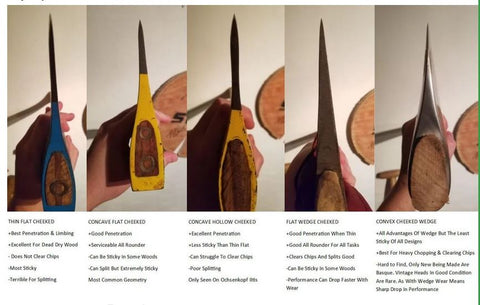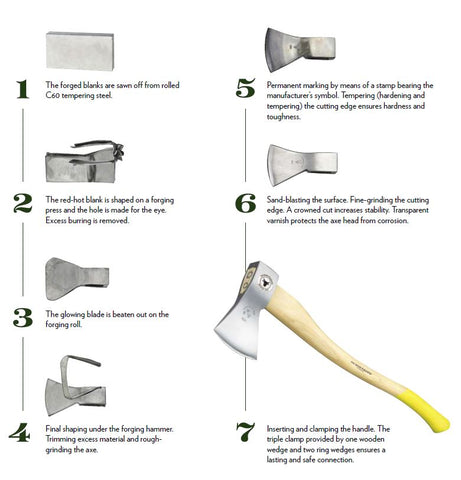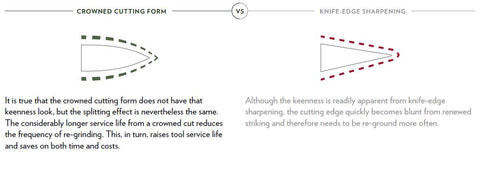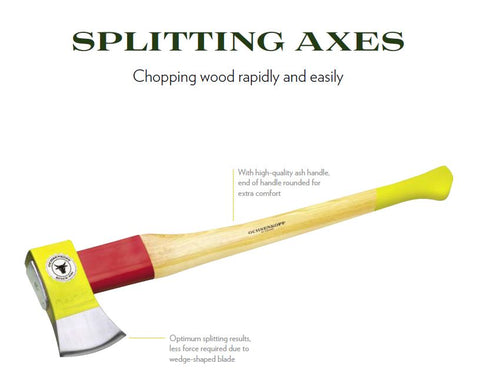 Strangely enough, if you search online you’ll find a lot of people who are armchair experts on axes and also strangely enough, they seem to be able to find fault with just about any axe for being short of perfection. Or even a perceived notion of perfection. While one person may be incensed by the state of a given axe, another person may have nothing but high praise for the exact same axe. Perhaps this may be due to variations in the production of axes, or even type of axe, but it may also have something to do with the fact that what people have learned about axes was not learned from an authoritative source. In other words, what was learned may not be correct and so what has become one person’s measure of quality may not actually be the right way to identify how good an axe is. Or conversely, maybe those giving a clean bill of health to a particular axe just have no clue what they’re talking about and why the axe is awful.
Strangely enough, if you search online you’ll find a lot of people who are armchair experts on axes and also strangely enough, they seem to be able to find fault with just about any axe for being short of perfection. Or even a perceived notion of perfection. While one person may be incensed by the state of a given axe, another person may have nothing but high praise for the exact same axe. Perhaps this may be due to variations in the production of axes, or even type of axe, but it may also have something to do with the fact that what people have learned about axes was not learned from an authoritative source. In other words, what was learned may not be correct and so what has become one person’s measure of quality may not actually be the right way to identify how good an axe is. Or conversely, maybe those giving a clean bill of health to a particular axe just have no clue what they’re talking about and why the axe is awful.
Maybe the truth is somewhere in the middle.
To help those who know nothing about axes separate the wheat from the chaff in online forums, and to hopefully help all of us identify whether an axe we’ve bought is good or not, we’ll be looking at what “normal” is for a given axe head, because it’s important to use the right axe for the job and of course, proper care of your axe, once you’ve found it acceptable, is also important. At the moment, we’ll be looking specifically at Ochsenkopf because some of their axe-making wisdom can apply to axes in general because what’s true about the shape of one axe and how it chops should carry across to any brand. Ochsenkopf is a good brand to look to in general though, simply because they’ve been in the axe-making business since 1781. Even with the changes in technology and methods over time, they’ve got to be doing something right to still be in business after this many years. Not to mention that there are very few negative things online about Ochsenkopf, which is surprising on the internet in this day.
 For starters, despite a very small amount of online chatter about Ochsenkopf casting their axe heads, they actually do forge them. Ochsenkopf axes are forged from C60 steel – a common steel for tools and axes – due to its toughness. Forging of course is also one of the keys to a strong and reliable tool. While red hot, the Ochsenkopf axe head is shaped on a forging press (probably similar to this in many respects) until a red hot blade is created, then extra material is trimmed off. The axe head is tempered and hardened and the edge is honed to the optimal shape, hardness and sharpness.
For starters, despite a very small amount of online chatter about Ochsenkopf casting their axe heads, they actually do forge them. Ochsenkopf axes are forged from C60 steel – a common steel for tools and axes – due to its toughness. Forging of course is also one of the keys to a strong and reliable tool. While red hot, the Ochsenkopf axe head is shaped on a forging press (probably similar to this in many respects) until a red hot blade is created, then extra material is trimmed off. The axe head is tempered and hardened and the edge is honed to the optimal shape, hardness and sharpness.
But what is the optimal sharpness for an axe? Ochsenkopf prefers to hone their axes to a cambered (arch-shaped, also referred to as crowned cutting form) edge as opposed to knife edge sharp as it cuts virtually the same and extends the life of the blade.  It’s quite possible that someone, especially new to axes, might expect a thin, razor sharp tool when in fact that’s not a preferred blade on an axe. Although there are some who swear by using an axe sharp enough to shave with, it seems this might mean keeping the cambered shape while ensuring the edge is sharp enough to shave with, because Ochsenkopf’s own sharpening guide does recommend keeping and using a sharp axe, so logically Ochsenkopf has found a sharp cambered edge to be optimal.
It’s quite possible that someone, especially new to axes, might expect a thin, razor sharp tool when in fact that’s not a preferred blade on an axe. Although there are some who swear by using an axe sharp enough to shave with, it seems this might mean keeping the cambered shape while ensuring the edge is sharp enough to shave with, because Ochsenkopf’s own sharpening guide does recommend keeping and using a sharp axe, so logically Ochsenkopf has found a sharp cambered edge to be optimal.
In either case, finding the right balance could be tricky, but with experience should become easier. Ochsenkopf recommends cambered edge over knife edge because with knife edge, axe blades tend to blunt quickly requiring re-grinding more often, so keep that in mind when you get a new axe and are sizing it up. A fair number of the complaints about axes online is that “they aren’t sharp enough” or that they’re “not ground properly,” however if you know the advantages of the crowned cutting form, and the right level of sharpness, you may not jump so quickly to identifying an axe as substandard.
 The next most important way to ensure quality in your axe is to choose the right axe for the job you’re going to do. Ochsenkopf has an axe selector to help you, but you can also tell from the shape of the head, to a certain extent, if you’re using the right axe for the job. Splitting of wood should of course be done with a splitting axe like the Ox 630 or the Ox 648. Splitting axes are made with a much wider striking face – akin to a hammer – making the job of splitting much easier. For felling trees, lopping off tree limbs, debarking and general tree care, the Ox 10 H and others in the Iltis series by Ochsenkopf have the ideal shape. The Iltis features a thinner blade, which is springy and made of special steel to prevent breaking. The Ox 16 H double bit axe once favored by lumberjacks) in the Iltis series features two faces – one of which is ground more finely for felling the tree and the other side is a tad more blunt for de-limbing. Lastly, for good “all-round” work encompassing all three functions (felling, de-limbing, and splitting), Ochsenkopf’s Universal axes are the way to go because they’re kind of a hybrid of the other two types. You can see in the Ox 620 H and others that the head is wider than the Iltis making it better for splitting, and thinner than the splitting axes making it a good match for the work the Iltis does.
The next most important way to ensure quality in your axe is to choose the right axe for the job you’re going to do. Ochsenkopf has an axe selector to help you, but you can also tell from the shape of the head, to a certain extent, if you’re using the right axe for the job. Splitting of wood should of course be done with a splitting axe like the Ox 630 or the Ox 648. Splitting axes are made with a much wider striking face – akin to a hammer – making the job of splitting much easier. For felling trees, lopping off tree limbs, debarking and general tree care, the Ox 10 H and others in the Iltis series by Ochsenkopf have the ideal shape. The Iltis features a thinner blade, which is springy and made of special steel to prevent breaking. The Ox 16 H double bit axe once favored by lumberjacks) in the Iltis series features two faces – one of which is ground more finely for felling the tree and the other side is a tad more blunt for de-limbing. Lastly, for good “all-round” work encompassing all three functions (felling, de-limbing, and splitting), Ochsenkopf’s Universal axes are the way to go because they’re kind of a hybrid of the other two types. You can see in the Ox 620 H and others that the head is wider than the Iltis making it better for splitting, and thinner than the splitting axes making it a good match for the work the Iltis does.
As you can see, if one were to try to use the splitting axe to fell a tree or prune limbs, you would have less success, likewise with using the Iltis to split. Ensuring the right shape axe head for the job is the key to success. Who knows how many axe users online are getting the wrong axe for the job, meeting with failure then complaining that the axe sucks. By knowing what axe to use you’ll have a more realistic picture of what the axe should look like.
So as you encounter online axe experts and become one yourself, make sure you do good research to ensure the information you find is good. Learn as much as you can from axe makers online, watch videos by guys who really know their stuff and read old literature on axe care. Then, maybe try a few things on your own so you can set people straight in online forums, and when you get your axe you’ll be able to tell if it’s good right away!


























Leave a comment